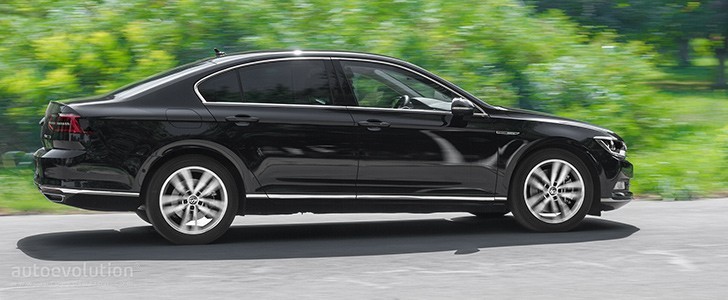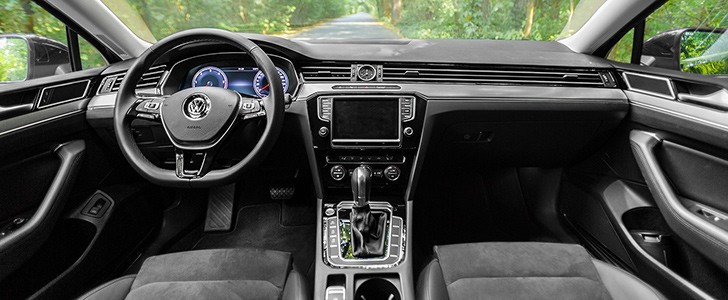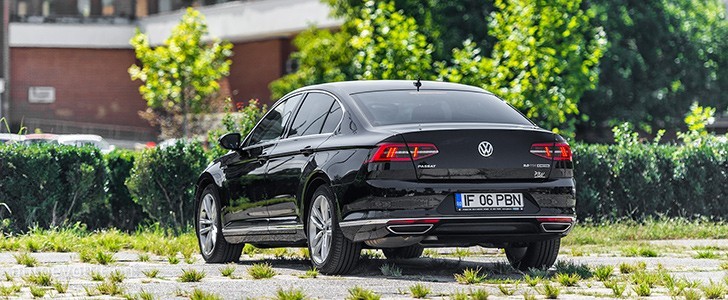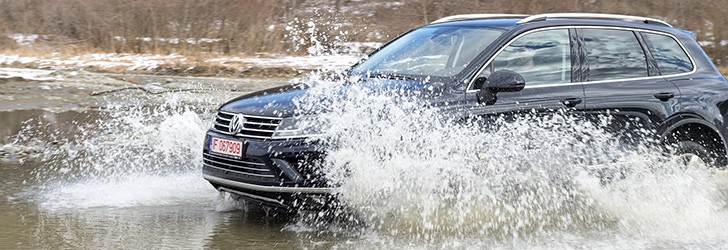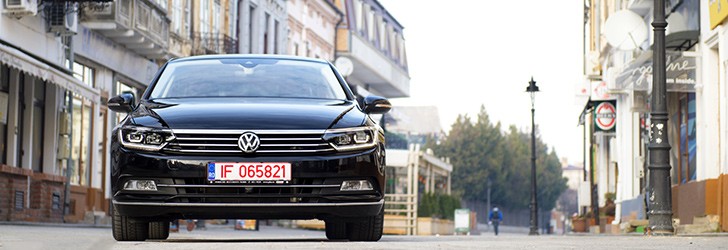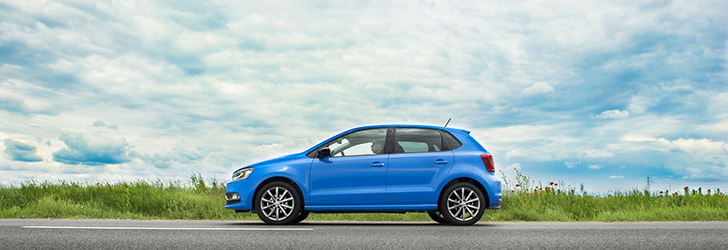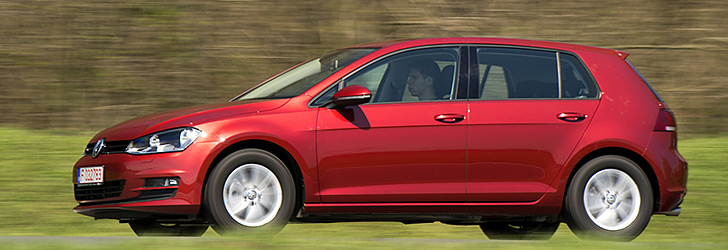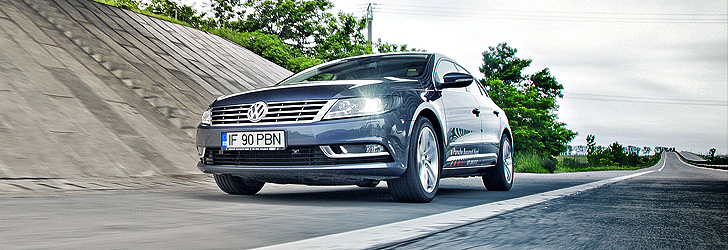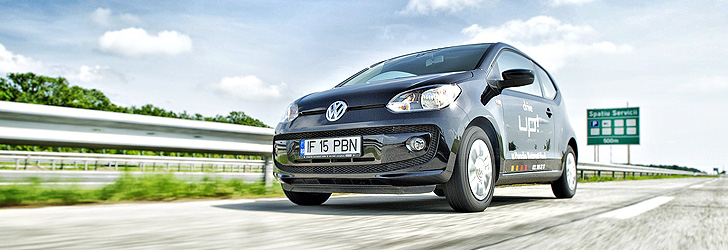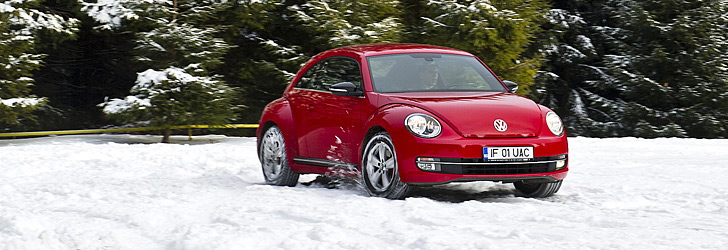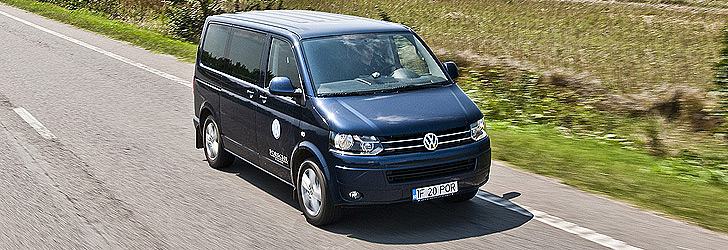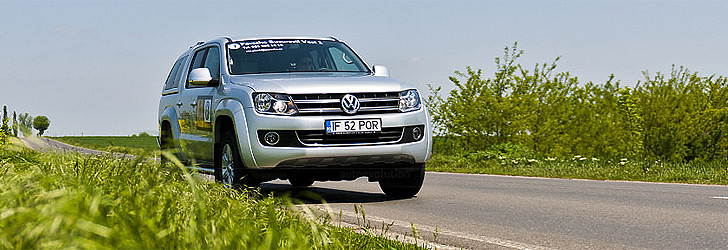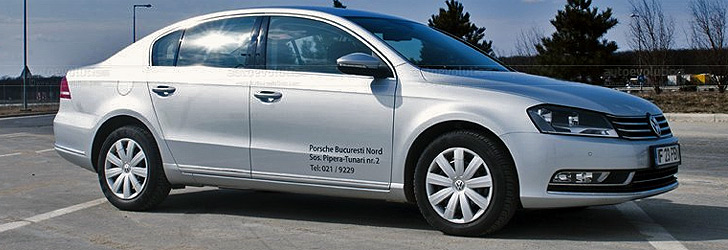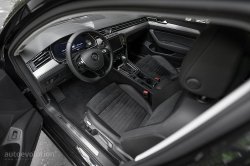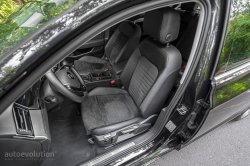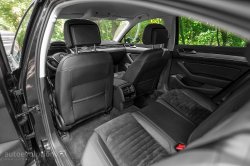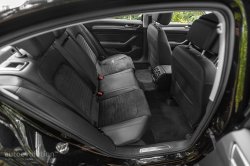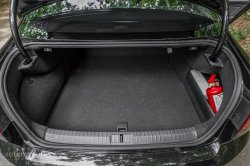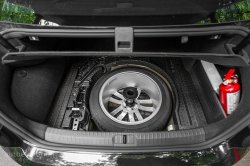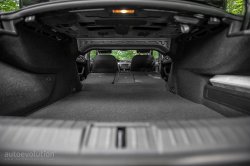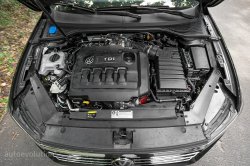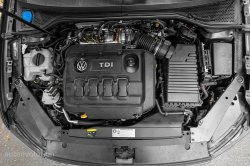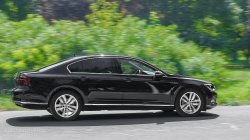2016 Volkswagen Passat 2.0 BiTDI 4Motion Review
OUR TEST CAR: 2016 Volkswagen Passat 2.0 BiTDI 4Motion
The VW Passat is one of the few sedans that competes against both mainstream and premium adversaries. It needs a suitable set of weapons to do that, and today we got to test the sharpest one of all, the special engine developed for the 2015 Passat 2.0 BiTDI 4Motion. It uses not one but two turbochargers to get the highest output of any 2-liter turbodiesel engine on the market.
As the model's name suggests, all-wheel drive is offered as standard. In combination with an all-new 7-speed DSG gearbox, the overall driving experience is impressive yet still predictable and entirely rational. This is what the Germans do best: dull, logical engineering for everyday use.
Rumor has it that Volkswagen has indefinitely delayed the launch of an all-new Phaeton saloon, even though all the initial development and design work is complete. The current model is over a decade old, and we thus consider the Passat 2.0 BiTDI 4Motion to be the true flagship of the Volkswagen brand. Can a mere 2.0-liter diesel engine live up to such high expectations? It can when it's accompanied by numerous other cutting-edge features.
The original Volkswagen Passat launched in 1973, one year before the first Golf. Over four decade ago, it was even offered as a 2-door sedan and used a four-cylinder 1.3-liter engine producing just 55 PS while the suspension system featured a rudimentary solid rear axle.
The first diesel Passat came in August 1975 with a 50 horsepower 1.6-liter mill derived from the Golf's 1.5-liter. Fast forward 40 years and the 8th generation Passat has a monster TDI engine with more power than the current Golf GTI hot hatch. Thanks to its 240 PS and 500 Nm (369 lb-ft) of torque, this rocket takes about 6 seconds to reach 100 km/h (62 mph) while never breaking a sweat.
The Passat has been a huge success story for Volkswagen, with about 23 million units sold so far. But before they launched the B8 generation, things looked bleak. Industry analysts were predicting the end of the mid-size sedan segment, which was being gobbled up by the SUVs and premium models from BMW and Mercedes. However, after the launch of the B8, demand across Europe skyrocketed and in August 2015 alone, the Passat saw 14,748 orders (+44.4%). That made it the fourth best selling model, outstripping much cheaper cars like the Ford Focus, Skoda Octavia and Opel Astra.
The 2015 Volkswagen Passat saloon has already impressed us when powered by a normal 2.0-liter TDI. It's a fine package of refinement and predictability that most (predominantly older male) customers seem to enjoy. However, it's also much more of a status symbol compared to the old generation, thanks to sharp styling and headline-grabbing technology.
While the new, sharper design looks longer and wider than the previous generation car, the 2015 Passat sedan is 2mm (0.08 inches) shorter. The overall height is 1,456mm (57.3 inches), down by 14mm (0.55 inches) to improve handling. Despite this, headroom is 26mm (1 inch) more ample because the seats are positioned closer to the ground. Engineers played around with the MQB modular platform until they managed to extend the wheelbase by 79 mm (3.11 inches) to 2,791 mm (109.9 inches), resulting in a much more spacious interior.
Another thing the Passat doesn't lack is diversity, as the three conventional trim levels can be combined with one of 9 four-cylinder mills (5 petrol and 4 diesel) all of them turbocharged and pushing between 120 and 280 PS. Also, there's a dedicated BlueMotion that drinks with a pipette and the GTE plug-in hybrid that has blue accents all over.
The first task VW designers received must have been not to offend existing Passat owners. I know the old model seems different, but the long horizontal line that passes through the door handle and those strong hood shapes on the hood are the same as before. Everybody knows those features belong to the Passat, and since millions have bought one there's no need to rock the boat.
In sharp contrast to older Volkswagen models, many customers buy the Passat BECAUSE of its design, not despite it. It's quite interesting to see how its arrival hurt sales of the CC four-door coupe, which some dealerships aren't even keeping on their lots. ((What Volkswagen hasn't managed to do is to "pull a Mazda6", basically a car that's so fresh that it makes the old one look obsolete and dated. Another problem is that with basic halogen headlights and 16-inch wheels, the 2015 Passat might as well have been designed in 2005. However, that's just every German company's way of reaching into your pockets.
We think that the overall design works best with 18-inch wheels, metallic paint, LED headlights and taillights. Compared to the previous model, it's much more of a looker, rousing the attention of VW fans wherever it goes. Many knew how much power the engine had and asked for a demo of the digital dash.
Having a quick look under the hood is very easy because the motion is supported by a hydraulic piston on the right. Black capsules neatly cover everything, but the mother of all turbochargers next to the firewall is still visible. Its silicone piping made us wonder if this Volkswagen engine doesn't secretly want to be in a Subaru Impreza WRX.
To unlock the car, you simply have to keep the smart key in your pocket. The Passat senses when you are near, and there's no need to press a button on the door like with "smart keys" from other brands.
The interior is definitely a premium one, a cut above any regular mid-size sedan. Everything feels nice to the touch, but the Mercedes-Benz C-Class is superior in terms of design, although it's to be expected considering the price gap. The Passat's cabin only comes alive at night, as blue ambient lighting washer over the doors and footwells. All the buttons and switches are illuminated in white, somewhat reminiscent of classic Nokia phones.
New Passats have the most interesting dash of any Volkswagen. However, that's not saying much at all. The long strip that defines the dash turns from a trim piece to an air vent and back to a trim piece again. It's nice, but Mercedes' brushed aluminum vents are undoubtedly more interesting. From the shape of the steering wheel to the placement of the analog clock, everything is as restrained as flatpack furniture.
It's hard to put your finger on it, but there's something deliberately imperfect about this car, like an underachieving beauty that doesn't want to work hard and become a supermodel. The seats are a good example, as they have heating, cooling and electrically adjustable lumbar support, yet don't help you with adjustment on the longitudinal axis. Why does a Mazda6 have that and not the Passat?
Despite our niggles, the outward visibility, cabin space, ergonomics and soundproofing levels are all perfect. These Germans are annoyingly good at what they do!
On the road, the Passat 2.0 BiTDI 4Motion feels pretty much the same as any model, with a hint of nose-heaviness on the limit. A "premium" steering system with very little feedback stops us from calling it fun-to-drive, but the power delivered by the engine is addictive.
The suspension system is derived from that of the Golf 7. It features MacPherson struts at the front and a four-link rear setup. The flagship BiTDI model also comes with fluid-filled bushings at the back so your passengers will feel just as comfortable as you do.
As standard, this 240 horsepower diesel is accompanied by VW’s Dynamic Chassis Control system (magnetic dampers) and progressive steering from the GTI Performance Pack (not as finger-tippy though). Everything is tailored through the familiar ‘Comfort’, ‘Normal’, ‘Sport’ and ‘Individual’ modes.
None of them will tell you what the front tires are doing, and the Sport mode is like a sparring match where nobody gets hurt so you can use it around town. With so much weight on the front axle, things can get a little jittery at times, though going faster fixes the problem. While the diesel engine can rev quite easily beyond 4,000rpm, there is no sense of crescendo and climax, like you get when a TSI has its cogs swapped at the top end.
In case you didn't catch this from the start, out test car is equipped with a powerful diesel engine. Contrary to what you and I might expect, the 240 PS diesel engine doesn't turn the Passat into a sports car or even a GTI What you get is a grand tourer with ample power reserves.
When driving around in comfort mode, the DSG gearbox changes cogs seamlessly, usually below 2,000rpm. Because there are two turbochargers, lag is noticeably reduced, this being one of the smoothest TDI engines we have ever tested. Meanwhile, the torque feel is identical to that of a V6.
Volkswagen tried to make a super-Passat before. For example, the B5.5 offered a W8 4.0-liter engine with 275 PS between 2001 and 2004. However, only 10,000 units were sold. When the B6 came out a year later, the overcomplicated 8-cylinder was replaced by the 3.6-liter VR6. Of course, using two turbochargers on the 2.0 TDI is a smarter idea, more in tune with the times.
All of Volkswagen's TDI engines have lost weight and gained stop-start functions. It's a crucial feature in the fuel saving battle, which the Passat cannot afford to lose. About 90% of all models sold in Germany come with diesel engines, and about half of those belong to the company car market, where every gram of CO2 matters.
Within the non-premium segment, the Passat BiTDI is in a class of its own. French competitors like the Citroen C5 3.0 V6 HDI or Renault Latitude 3.0 V6 dCi are going to be retired soon because they don't comply with the latest emissions regulations. The Opel Insignia and Skoda Superb are not a match either, but Ford's new Mondeo packs a similar diesel engine with 210 PS. That might be enough for some, but VW has built a more solid reputation in this segment in the transmission and AWD departments.
However, even before setting foot in the new Passat, we knew that its biggest rival was going to be the BMW 3 Series. The Bavarian classic offers not one but two potential candidates, namely the 325d and the 330d. The first is powered by a twin-turbo 2.0-liter engine producing 218 PS, but it's not available with all-wheel drive while the second uses an inline-six 3.0-liter single-turbo engine to offer 258 PS. Should you buy one of those instead of the Passat? Maybe, but the 330d costs about €5,000 more and its cabin is small by comparison.
Mercedes doesn't have anything worth mentioning in the C-Class range. However, just like some people will always buy Volkswagens, others prefer the C250 d 4Matic (2.1-liter engine making 204 PS) because of its famous badge and curvaceous body.
In terms of performance, the Passat 2.0 BiTDI is once again out of the reach for normal D-segment sedans. It gets to 100 km/h (62 mph) in 6.1 seconds, while the V6-powered French cars we mentioned above need around 8 seconds. The funny thing is that an Opel Insignia OPC, which is labeled as a true performance car and packs a 325 horsepower V6, needs 6 seconds to reach 100 km/h.
However, the BMW 330d and Audi A4 3.0 TDI are worthy competitors, getting to the magic speed in 5.6s and 5.3s, respectively. Even though the Passat is not a gold medallist, it still comes home victorious from a confrontation with superior opponents.
In theory, the new 2.0 BiTDI perfectly combines power and efficiency. Volkswagen's official numbers suggest it drinks only 4.6 l/100km (51 mpg US) on the combined cycle, only a bit more than a 150 PS version of the same 2.0-liter engine. However, there's no such thing as a free lunch, as the 4Motion AWD and increased output are your worst enemy at the pump.
On the highway, the engine settles down at around 2,100rpm while you travel at 130 km/h in total comfort. However, even in Eco mode, we only managed 7.2 l/100km under these parameters. When we encountered regular city traffic, the numbers quickly climbed to 9.7 l/100km (24 mpg US) without us being zealous with the throttle.
The Passat has always had a 5-star safety rating, no matter what tests EuroNCAP imposes. There aren't any ugly surprises with the eighth generation, as Volkswagen engineers were proactive with the rigidity of the chassis and the variety of airbags included as standard.
We thus turn our attention to The City Emergency Braking system that can even detect pedestrians, though this is not the full extent of the safety toys available. The Passat can even reverse-park a caravan or trailer for you if you order the appropriate option. Our favorite toy has to be the blind spot monitoring system, which is excellent because the orange lights integrated into the mirrors are huge. Thus, even an elderly driver can easily see that there's a car in his blind spot.
Adaptive Cruise Control (ACC) is the most advanced tech feature on the new Passat if you exclude the digital dash. Just press a car-shaped button to the right of the steering wheel, set the following distance and be amazed when acceleration and braking are taken care of automatically. However, we think the idea of using it on your journey to work, as Volkswagen suggests in its commercials, is silly. The job of driving the Passat is already made extremely simple by the DSG gearbox, which comes with an Auto Hold function. Trust us when we say that your right foot will not feel as relaxed in some BMW and Mercedes models as it does here, so ACC isn't needed.
While we're on the subject of pointless features, the Passat can also park itself using the Park Assist system. However, most mid-size sedan drivers are old, with decades of experience behind the wheel, so they don't need this kind of help. The Area View system (€800 option), consisting of four cameras, provides a bird's-eye of the car. We found that the resolution isn't great, and a simple reversing camera is enough when paired with parking sensors.
Finally, we arrive at the all-important discussion about price. There's no denying that at €49,490 our test Passat 2.0 BiTDI 4Motion Highline is expensive for a Volkswagen. However, the BMW 330d xDrive costs as much without any options and cannot match the Passat's in either cargo space (586 liters) or legroom.
The resolution of the Active Info Display is 1440 x 540 pixels, so it's about the same as an average tablet. It's not quite as good as Audi's Virtual Cockpit, but compared to a standard analog cluster, it's a lot more entertaining and practical. Volkswagen says its aim was to make driving safer by keeping your eyes closer to the road. However, it also has high entertainment value, impressing all your friends with a feature that not available on their C-Class or 3 Series.
The 240 PS diesel engine does a great job of waking you up in the morning, but for the sweet spot of the range, most rational customers will look further down the price list than this BiTDI model. That's too bad because they will be missing out on a great GT car.
The 2015 Passat 2.0 BiTDI demands a lot of attention wherever it goes. It also spells the end of the discreet Passat family sedan and will serve as the pillar onto which Volkswagen will establish its premium brand.
Rumor has it that Volkswagen has indefinitely delayed the launch of an all-new Phaeton saloon, even though all the initial development and design work is complete. The current model is over a decade old, and we thus consider the Passat 2.0 BiTDI 4Motion to be the true flagship of the Volkswagen brand. Can a mere 2.0-liter diesel engine live up to such high expectations? It can when it's accompanied by numerous other cutting-edge features.
The original Volkswagen Passat launched in 1973, one year before the first Golf. Over four decade ago, it was even offered as a 2-door sedan and used a four-cylinder 1.3-liter engine producing just 55 PS while the suspension system featured a rudimentary solid rear axle.
The first diesel Passat came in August 1975 with a 50 horsepower 1.6-liter mill derived from the Golf's 1.5-liter. Fast forward 40 years and the 8th generation Passat has a monster TDI engine with more power than the current Golf GTI hot hatch. Thanks to its 240 PS and 500 Nm (369 lb-ft) of torque, this rocket takes about 6 seconds to reach 100 km/h (62 mph) while never breaking a sweat.
The 2.0 BiTDI engine is a perfect metaphor for Volkswagen, a company drunk on power and technology.
The Passat has been a huge success story for Volkswagen, with about 23 million units sold so far. But before they launched the B8 generation, things looked bleak. Industry analysts were predicting the end of the mid-size sedan segment, which was being gobbled up by the SUVs and premium models from BMW and Mercedes. However, after the launch of the B8, demand across Europe skyrocketed and in August 2015 alone, the Passat saw 14,748 orders (+44.4%). That made it the fourth best selling model, outstripping much cheaper cars like the Ford Focus, Skoda Octavia and Opel Astra.
The 2015 Volkswagen Passat saloon has already impressed us when powered by a normal 2.0-liter TDI. It's a fine package of refinement and predictability that most (predominantly older male) customers seem to enjoy. However, it's also much more of a status symbol compared to the old generation, thanks to sharp styling and headline-grabbing technology.
While the new, sharper design looks longer and wider than the previous generation car, the 2015 Passat sedan is 2mm (0.08 inches) shorter. The overall height is 1,456mm (57.3 inches), down by 14mm (0.55 inches) to improve handling. Despite this, headroom is 26mm (1 inch) more ample because the seats are positioned closer to the ground. Engineers played around with the MQB modular platform until they managed to extend the wheelbase by 79 mm (3.11 inches) to 2,791 mm (109.9 inches), resulting in a much more spacious interior.
Another thing the Passat doesn't lack is diversity, as the three conventional trim levels can be combined with one of 9 four-cylinder mills (5 petrol and 4 diesel) all of them turbocharged and pushing between 120 and 280 PS. Also, there's a dedicated BlueMotion that drinks with a pipette and the GTE plug-in hybrid that has blue accents all over.
The first task VW designers received must have been not to offend existing Passat owners. I know the old model seems different, but the long horizontal line that passes through the door handle and those strong hood shapes on the hood are the same as before. Everybody knows those features belong to the Passat, and since millions have bought one there's no need to rock the boat.
In sharp contrast to older Volkswagen models, many customers buy the Passat BECAUSE of its design, not despite it. It's quite interesting to see how its arrival hurt sales of the CC four-door coupe, which some dealerships aren't even keeping on their lots. ((What Volkswagen hasn't managed to do is to "pull a Mazda6", basically a car that's so fresh that it makes the old one look obsolete and dated. Another problem is that with basic halogen headlights and 16-inch wheels, the 2015 Passat might as well have been designed in 2005. However, that's just every German company's way of reaching into your pockets.
We think that the overall design works best with 18-inch wheels, metallic paint, LED headlights and taillights. Compared to the previous model, it's much more of a looker, rousing the attention of VW fans wherever it goes. Many knew how much power the engine had and asked for a demo of the digital dash.
Having a quick look under the hood is very easy because the motion is supported by a hydraulic piston on the right. Black capsules neatly cover everything, but the mother of all turbochargers next to the firewall is still visible. Its silicone piping made us wonder if this Volkswagen engine doesn't secretly want to be in a Subaru Impreza WRX.
To unlock the car, you simply have to keep the smart key in your pocket. The Passat senses when you are near, and there's no need to press a button on the door like with "smart keys" from other brands.
The interior is definitely a premium one, a cut above any regular mid-size sedan. Everything feels nice to the touch, but the Mercedes-Benz C-Class is superior in terms of design, although it's to be expected considering the price gap. The Passat's cabin only comes alive at night, as blue ambient lighting washer over the doors and footwells. All the buttons and switches are illuminated in white, somewhat reminiscent of classic Nokia phones.
New Passats have the most interesting dash of any Volkswagen. However, that's not saying much at all. The long strip that defines the dash turns from a trim piece to an air vent and back to a trim piece again. It's nice, but Mercedes' brushed aluminum vents are undoubtedly more interesting. From the shape of the steering wheel to the placement of the analog clock, everything is as restrained as flatpack furniture.
It's hard to put your finger on it, but there's something deliberately imperfect about this car, like an underachieving beauty that doesn't want to work hard and become a supermodel. The seats are a good example, as they have heating, cooling and electrically adjustable lumbar support, yet don't help you with adjustment on the longitudinal axis. Why does a Mazda6 have that and not the Passat?
Despite our niggles, the outward visibility, cabin space, ergonomics and soundproofing levels are all perfect. These Germans are annoyingly good at what they do!
On the road, the Passat 2.0 BiTDI 4Motion feels pretty much the same as any model, with a hint of nose-heaviness on the limit. A "premium" steering system with very little feedback stops us from calling it fun-to-drive, but the power delivered by the engine is addictive.
The suspension system is derived from that of the Golf 7. It features MacPherson struts at the front and a four-link rear setup. The flagship BiTDI model also comes with fluid-filled bushings at the back so your passengers will feel just as comfortable as you do.
The 4Motion system doesn't feel like a German Jeep; it feels like FWD with infinite grip.
As standard, this 240 horsepower diesel is accompanied by VW’s Dynamic Chassis Control system (magnetic dampers) and progressive steering from the GTI Performance Pack (not as finger-tippy though). Everything is tailored through the familiar ‘Comfort’, ‘Normal’, ‘Sport’ and ‘Individual’ modes.
None of them will tell you what the front tires are doing, and the Sport mode is like a sparring match where nobody gets hurt so you can use it around town. With so much weight on the front axle, things can get a little jittery at times, though going faster fixes the problem. While the diesel engine can rev quite easily beyond 4,000rpm, there is no sense of crescendo and climax, like you get when a TSI has its cogs swapped at the top end.
In case you didn't catch this from the start, out test car is equipped with a powerful diesel engine. Contrary to what you and I might expect, the 240 PS diesel engine doesn't turn the Passat into a sports car or even a GTI What you get is a grand tourer with ample power reserves.
When driving around in comfort mode, the DSG gearbox changes cogs seamlessly, usually below 2,000rpm. Because there are two turbochargers, lag is noticeably reduced, this being one of the smoothest TDI engines we have ever tested. Meanwhile, the torque feel is identical to that of a V6.
Volkswagen tried to make a super-Passat before. For example, the B5.5 offered a W8 4.0-liter engine with 275 PS between 2001 and 2004. However, only 10,000 units were sold. When the B6 came out a year later, the overcomplicated 8-cylinder was replaced by the 3.6-liter VR6. Of course, using two turbochargers on the 2.0 TDI is a smarter idea, more in tune with the times.
All of Volkswagen's TDI engines have lost weight and gained stop-start functions. It's a crucial feature in the fuel saving battle, which the Passat cannot afford to lose. About 90% of all models sold in Germany come with diesel engines, and about half of those belong to the company car market, where every gram of CO2 matters.
Within the non-premium segment, the Passat BiTDI is in a class of its own. French competitors like the Citroen C5 3.0 V6 HDI or Renault Latitude 3.0 V6 dCi are going to be retired soon because they don't comply with the latest emissions regulations. The Opel Insignia and Skoda Superb are not a match either, but Ford's new Mondeo packs a similar diesel engine with 210 PS. That might be enough for some, but VW has built a more solid reputation in this segment in the transmission and AWD departments.
However, even before setting foot in the new Passat, we knew that its biggest rival was going to be the BMW 3 Series. The Bavarian classic offers not one but two potential candidates, namely the 325d and the 330d. The first is powered by a twin-turbo 2.0-liter engine producing 218 PS, but it's not available with all-wheel drive while the second uses an inline-six 3.0-liter single-turbo engine to offer 258 PS. Should you buy one of those instead of the Passat? Maybe, but the 330d costs about €5,000 more and its cabin is small by comparison.
Mercedes doesn't have anything worth mentioning in the C-Class range. However, just like some people will always buy Volkswagens, others prefer the C250 d 4Matic (2.1-liter engine making 204 PS) because of its famous badge and curvaceous body.
In terms of performance, the Passat 2.0 BiTDI is once again out of the reach for normal D-segment sedans. It gets to 100 km/h (62 mph) in 6.1 seconds, while the V6-powered French cars we mentioned above need around 8 seconds. The funny thing is that an Opel Insignia OPC, which is labeled as a true performance car and packs a 325 horsepower V6, needs 6 seconds to reach 100 km/h.
However, the BMW 330d and Audi A4 3.0 TDI are worthy competitors, getting to the magic speed in 5.6s and 5.3s, respectively. Even though the Passat is not a gold medallist, it still comes home victorious from a confrontation with superior opponents.
In theory, the new 2.0 BiTDI perfectly combines power and efficiency. Volkswagen's official numbers suggest it drinks only 4.6 l/100km (51 mpg US) on the combined cycle, only a bit more than a 150 PS version of the same 2.0-liter engine. However, there's no such thing as a free lunch, as the 4Motion AWD and increased output are your worst enemy at the pump.
On the highway, the engine settles down at around 2,100rpm while you travel at 130 km/h in total comfort. However, even in Eco mode, we only managed 7.2 l/100km under these parameters. When we encountered regular city traffic, the numbers quickly climbed to 9.7 l/100km (24 mpg US) without us being zealous with the throttle.
The Passat has always had a 5-star safety rating, no matter what tests EuroNCAP imposes. There aren't any ugly surprises with the eighth generation, as Volkswagen engineers were proactive with the rigidity of the chassis and the variety of airbags included as standard.
We thus turn our attention to The City Emergency Braking system that can even detect pedestrians, though this is not the full extent of the safety toys available. The Passat can even reverse-park a caravan or trailer for you if you order the appropriate option. Our favorite toy has to be the blind spot monitoring system, which is excellent because the orange lights integrated into the mirrors are huge. Thus, even an elderly driver can easily see that there's a car in his blind spot.
Adaptive Cruise Control (ACC) is the most advanced tech feature on the new Passat if you exclude the digital dash. Just press a car-shaped button to the right of the steering wheel, set the following distance and be amazed when acceleration and braking are taken care of automatically. However, we think the idea of using it on your journey to work, as Volkswagen suggests in its commercials, is silly. The job of driving the Passat is already made extremely simple by the DSG gearbox, which comes with an Auto Hold function. Trust us when we say that your right foot will not feel as relaxed in some BMW and Mercedes models as it does here, so ACC isn't needed.
While we're on the subject of pointless features, the Passat can also park itself using the Park Assist system. However, most mid-size sedan drivers are old, with decades of experience behind the wheel, so they don't need this kind of help. The Area View system (€800 option), consisting of four cameras, provides a bird's-eye of the car. We found that the resolution isn't great, and a simple reversing camera is enough when paired with parking sensors.
Finally, we arrive at the all-important discussion about price. There's no denying that at €49,490 our test Passat 2.0 BiTDI 4Motion Highline is expensive for a Volkswagen. However, the BMW 330d xDrive costs as much without any options and cannot match the Passat's in either cargo space (586 liters) or legroom.
You'd be a fool not to order the 12.3-inch digital dashboard system.
The resolution of the Active Info Display is 1440 x 540 pixels, so it's about the same as an average tablet. It's not quite as good as Audi's Virtual Cockpit, but compared to a standard analog cluster, it's a lot more entertaining and practical. Volkswagen says its aim was to make driving safer by keeping your eyes closer to the road. However, it also has high entertainment value, impressing all your friends with a feature that not available on their C-Class or 3 Series.
The 240 PS diesel engine does a great job of waking you up in the morning, but for the sweet spot of the range, most rational customers will look further down the price list than this BiTDI model. That's too bad because they will be missing out on a great GT car.
The 2015 Passat 2.0 BiTDI demands a lot of attention wherever it goes. It also spells the end of the discreet Passat family sedan and will serve as the pillar onto which Volkswagen will establish its premium brand.
Our VOLKSWAGEN Testdrives:
Photo gallery (68)
